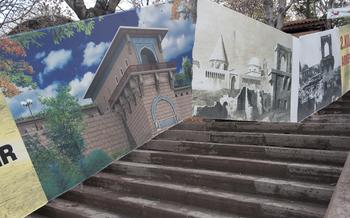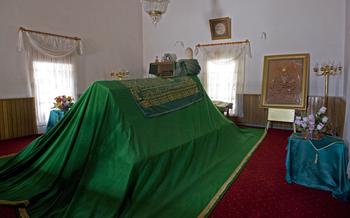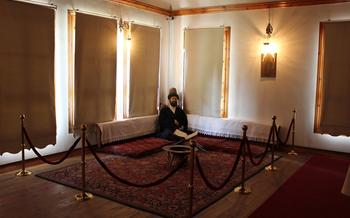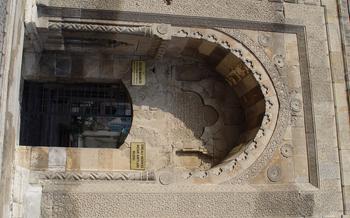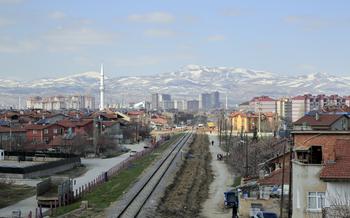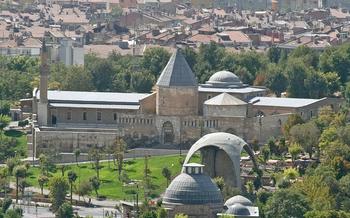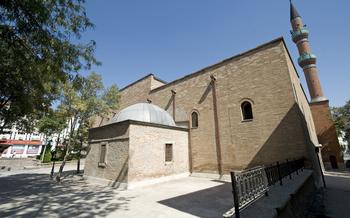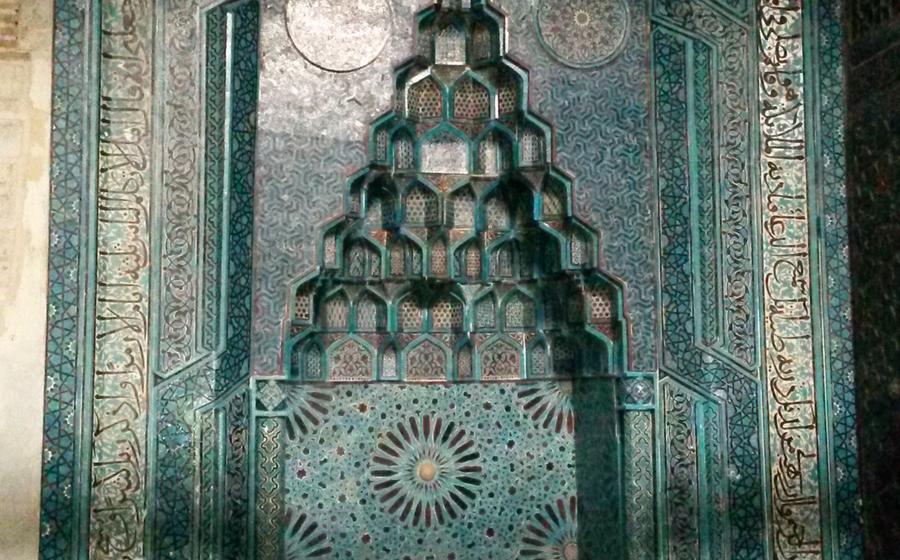
Esrefoglu Mosque
- Esrefoglu Mosque: A Journey Through History and Architecture
- Historical Significance
- Architectural Marvel
- Interior Splendor
- Religious Importance
- Symbol of Konya
- UNESCO World Heritage Site
- Tips for Visitors
- Insider Tip:
- Photography Opportunities:
- Local Culture and Customs
- Historical Context
- Restoration and Preservation
- Unique Architectural Elements
- Religious Rituals and Practices
- Local Legends and Folklore
- Insider Tip: Unveiling Hidden Treasures
Esrefoglu Mosque: A Journey Through History and Architecture
Historical Significance
The Esrefoglu Mosque, a magnificent architectural masterpiece, stands as a testament to the rich history and cultural heritage of Konya. Built in the 13th century during the Seljuk period, the mosque played a pivotal role in the development of Seljuk architecture, blending traditional Islamic elements with unique Anatolian influences. Its intricate tilework, elegant calligraphy, and stunning design showcase the height of Seljuk artistry and craftsmanship. The mosque's historical significance extends beyond its architectural beauty, as it served as a center of religious and social life for the local community, fostering a deep connection between the people and their faith.
Architectural Marvel
The Esrefoglu Mosque stands as a testament to the architectural prowess of the Seljuk era. Its design showcases a harmonious blend of Seljuk and Anatolian architectural elements, resulting in a unique and captivating structure. The mosque's facade is adorned with intricate tilework and calligraphic inscriptions, creating a visually stunning tapestry that draws the eye.
The mosque's most prominent feature is its towering minaret, which rises majestically above the cityscape. The minaret's fluted shaft is adorned with geometric patterns and decorative bands, showcasing the Seljuk mastery of ornamentation. Its elegant silhouette dominates the skyline, serving as a beacon for worshipers and a symbol of Konya's rich architectural heritage.
The courtyard of the mosque is a serene and contemplative space, framed by elegant arcades supported by slender columns. The arches, adorned with delicate carvings and inscriptions, create a rhythmic pattern that adds visual interest and emphasizes the mosque's architectural symmetry. The courtyard provides a tranquil oasis, inviting visitors to pause and reflect before entering the sacred space of the prayer hall.
The mosque's interior is equally impressive, featuring a spacious prayer hall supported by rows of massive columns. The columns, adorned with intricate carvings and decorative capitals, create a sense of grandeur and awe. The mihrab, the focal point of the prayer hall, is a masterpiece of craftsmanship, featuring intricate tilework and calligraphic inscriptions that exude an aura of spirituality.
The Esrefoglu Mosque's architecture seamlessly blends functionality with aesthetics, creating a sacred space that inspires devotion and contemplation. Its unique features, such as the minaret, courtyard, and prayer hall, exemplify the architectural brilliance of the Seljuk era and make it a must-visit destination for anyone interested in Islamic architecture.
Interior Splendor
The interior of the Esrefoglu Mosque is a testament to the artistry and craftsmanship of the Seljuk era. The mihrab, an exquisitely carved niche indicating the direction of Mecca, is the focal point of the mosque. Intricate tilework and calligraphy adorn the mihrab, creating a sense of awe and reverence. The minbar, a stepped pulpit from which the imam delivers sermons, is another masterpiece of Seljuk craftsmanship. Its intricate carvings and geometric patterns showcase the exceptional skills of the artisans who created it.
The mosque's interior is also adorned with stunning tilework and calligraphy. The tiles, in vibrant shades of blue, green, and turquoise, depict intricate geometric patterns and verses from the Quran. The calligraphy, executed in elegant Arabic script, adds a touch of sophistication and spirituality to the mosque's interior. The overall effect is one of overwhelming beauty and grandeur, creating a sense of tranquility and inspiration for those who visit.
Religious Importance
The Esrefoglu Mosque holds immense religious significance to Muslims, serving as a sacred place of worship and spiritual connection. Situated in Konya, a city renowned for its rich Islamic heritage, the mosque has become an integral part of the local community's religious life. For centuries, the faithful have flocked to this sacred space to offer their prayers, seek solace, and deepen their connection with the divine.
The mosque's location in Konya, a city that was once the capital of the Seljuk Sultanate, further enhances its religious importance. During the Seljuk period, Konya was a thriving center of Islamic scholarship and culture, and the Esrefoglu Mosque played a pivotal role in the city's religious life. Today, the mosque continues to be a symbol of Konya's strong Islamic heritage, attracting worshippers and visitors from around the world.
Symbol of Konya
The Esrefoglu Mosque stands as a proud symbol of Konya, a city deeply rooted in Islamic history and culture. Its towering minarets and intricate tilework have become synonymous with the city's identity, attracting visitors from around the world who come to marvel at its architectural splendor. The mosque's unique blend of Seljuk and Ottoman influences reflects the city's rich history as a crossroads of civilizations.
As a symbol of Konya, the Esrefoglu Mosque plays a vital role in promoting the city's cultural heritage. It serves as a reminder of the city's significant contributions to Islamic architecture and art, showcasing the skill and artistry of its builders. The mosque's presence has helped to preserve and promote traditional Turkish crafts, such as tile-making and calligraphy, which continue to thrive in the city today.
Through its architectural magnificence and historical significance, the Esrefoglu Mosque has become an integral part of Konya's identity. It is a source of pride for the local community and a symbol of the city's rich cultural tapestry. Visitors to Konya are sure to be captivated by the mosque's beauty and inspired by its enduring legacy.
UNESCO World Heritage Site
The Esrefoglu Mosque's exceptional historical and architectural significance has earned it recognition as a UNESCO World Heritage Site. This prestigious designation was bestowed upon the mosque in 2012, cementing its status as a cultural treasure of global importance. The mosque's inclusion on the World Heritage List is a testament to its outstanding universal value, meeting several key criteria set forth by UNESCO.
The mosque's architectural and artistic achievements, particularly its intricate tilework and calligraphy, represent a unique and exceptional example of Seljuk architecture. The mosque's innovative use of space and its harmonious blend of decorative elements showcase the genius of Seljuk craftsmanship. Furthermore, the mosque's well-preserved state and its continuous use as a place of worship contribute to its outstanding value.
The Esrefoglu Mosque stands as a symbol of Konya's rich cultural heritage and its pivotal role in the development of Islamic architecture. The mosque's designation as a UNESCO World Heritage Site underscores the international community's recognition of its exceptional value and the need to preserve and protect it for future generations.
Tips for Visitors
When visiting the Esrefoglu Mosque, it is important to be respectful of the religious and cultural significance of the site. Visitors should dress modestly and remove their shoes before entering the mosque. It is also important to be mindful of the worshippers and avoid talking or making noise during prayer times.
The best time to visit the Esrefoglu Mosque is during the morning or late afternoon when the light is most beautiful. Visitors should also take their time to explore the mosque's exterior and interior, paying attention to the intricate details of the architecture and decoration.
After visiting the mosque, visitors can explore the surrounding area, which is home to several other historical and cultural attractions. The Alaeddin Mosque, the Mevlana Museum, and the Sille Village are all within walking distance of the Esrefoglu Mosque.
Visitors can also enjoy a traditional Turkish meal at one of the many restaurants and cafes in the area. Some popular dishes to try include kebabs, pide, and Turkish delight.
Insider Tip:
For a unique perspective of the Esrefoglu Mosque, visitors can climb to the top of the minaret. This offers stunning views of the mosque and the surrounding city. However, it is important to be aware that the climb is quite steep and may not be suitable for everyone.
Photography Opportunities:
The Esrefoglu Mosque is a photographer's paradise, offering a treasure trove of photo opportunities that capture its architectural grandeur and intricate details. The best time to photograph the mosque is during the golden hour, when the warm light casts a magical glow on its facade. For sweeping vistas, head to the courtyard and capture the mosque's imposing minarets against the backdrop of Konya's cityscape. Don't miss the opportunity to photograph the mosque's stunning interior, with its intricate tilework, ornate calligraphy, and atmospheric lighting. A wide-angle lens is recommended to capture the mosque's vastness and grandeur. Remember to be respectful of worshippers and avoid using flash photography inside the mosque.
Local Culture and Customs
When visiting the Esrefoglu Mosque, it is important to be mindful of the local culture and customs. As a sign of respect, visitors should remove their shoes before entering the mosque. It is also important to dress modestly and avoid wearing revealing clothing. Visitors should be respectful of the worshippers and avoid talking or making loud noises during prayer times.
Taking the time to learn a few basic Turkish phrases can go a long way in showing respect for the local culture. Visitors can greet the locals with a simple "Merhaba" (Hello) or "Iyi gunler" (Good day). Thanking someone can be done by saying "Tesekkur ederim" (Thank you).
Interacting with the local community can be a rewarding experience. Visitors can visit local markets, cafes, and restaurants to sample traditional Turkish cuisine and engage with the friendly locals. Learning about Turkish customs and traditions can provide a deeper understanding of the country's rich cultural heritage.
Historical Context
Konya, an ancient city in central Anatolia, flourished as the capital of the Seljuk Sultanate during the 11th and 12th centuries. Under Seljuk rule, Konya became a major center of Islamic culture and learning, and the Esrefoglu Mosque stands as a testament to the city's significance during this period.
The Seljuks, a Turkic dynasty, played a pivotal role in the development of Islamic architecture. They synthesized various architectural influences, including Byzantine, Persian, and Mesopotamian, to create a unique style characterized by its grandeur, intricate ornamentation, and the use of stone and brick.
The Esrefoglu Mosque, built in the 13th century, embodies the architectural achievements of the Seljuks. Its monumental dome, soaring minarets, and exquisite tilework reflect the Seljuk mastery of structural design and artistic expression. The mosque's construction also marked a significant milestone in the development of the Seljuk Empire, solidifying Konya's position as a cultural and religious center in the Islamic world.
Restoration and Preservation
Over the centuries, the Esrefoglu Mosque has undergone several restoration and preservation efforts to maintain its historical integrity. These efforts have been crucial in safeguarding the mosque's original features and ensuring its continued existence for future generations.
One of the most significant restoration projects was undertaken in the 19th century under the leadership of Sultan Abdülmecid. During this period, the mosque's roof was repaired, and its interior and exterior were extensively renovated. The original tilework and calligraphy were meticulously restored, bringing back the mosque's vibrant colors and intricate designs.
In the 20th century, further restoration efforts were carried out by the Turkish government. These efforts focused on strengthening the mosque's structure, repairing damaged elements, and improving accessibility for visitors. The mosque's courtyard was also landscaped, and new lighting systems were installed to enhance the overall ambiance.
Preserving the Esrefoglu Mosque is an ongoing process that requires careful attention and expertise. The mosque's unique architectural features and historical significance make it a valuable cultural asset, and its preservation is essential for future generations to appreciate and learn from.
Unique Architectural Elements
The Esrefoglu Mosque stands out from other Seljuk mosques due to its distinctive architectural elements. One striking feature is its double-minaret design. While most Seljuk mosques have a single minaret, the Esrefoglu Mosque boasts two towering minarets that dominate the Konya skyline. The minarets are adorned with intricate tilework and calligraphy, showcasing the exceptional craftsmanship of the Seljuk era.
Another unique feature of the mosque is its elaborately carved portal. The entrance to the mosque is framed by a magnificent portal featuring intricate carvings of geometric patterns, floral motifs, and Quranic inscriptions. The portal is a testament to the Seljuks' mastery of stone carving and their attention to detail.
These unique architectural elements contribute to the overall aesthetic appeal of the Esrefoglu Mosque, making it a masterpiece of Seljuk architecture. They reflect the Seljuks' commitment to innovation and their ability to blend artistic expression with religious devotion.
Religious Rituals and Practices
The Esrefoglu Mosque is an active place of worship for Muslims in Konya. Several religious rituals and practices take place within its sacred walls, contributing to its spiritual atmosphere. The call to prayer, known as the "adhan," reverberates through the air five times a day, summoning the faithful to offer their prayers. The muezzin, or caller to prayer, stands atop the mosque's minaret and recites the adhan using a melodious voice that echoes through the surrounding streets.
During the holy month of Ramadan, the mosque comes alive with special prayers and activities. The "taraweeh" prayers, performed exclusively during Ramadan, draw large congregations who gather to recite long portions of the Quran. The mosque's interior is adorned with intricate decorations and illuminations, creating an ambiance of spirituality and devotion.
On Fridays, the weekly congregational prayer, known as the "jumu'ah," holds particular significance. Muslims from all over Konya converge at the mosque to offer prayers together. The imam, or prayer leader, delivers a sermon that addresses religious, social, and moral issues, guiding the community and fostering a sense of unity among the believers.
Local Legends and Folklore
The Esrefoglu Mosque is not only a testament to architectural brilliance but also a source of local legends and folklore that have been passed down through generations. One captivating tale revolves around a hidden treasure believed to be concealed within the mosque's walls. According to legend, a wealthy merchant who sought refuge in the mosque during troubled times entrusted his fortune to the mosque's imam for safekeeping. As time passed, the merchant vanished, and the secret of the treasure's whereabouts was lost. To this day, many believe that the treasure remains hidden within the mosque, waiting to be discovered by a worthy soul.
Insider Tip: Unveiling Hidden Treasures
For an unforgettable experience, venture beyond the main prayer hall and explore the hidden treasures that the Esrefoglu Mosque holds. As you wander through the mosque's serene courtyard, keep an eye out for a small, unassuming door nestled amidst the intricate tilework. This inconspicuous entrance leads to a secluded chamber known as the "secret room." Step inside, and you'll be greeted by a breathtaking sight—a beautifully preserved collection of ancient manuscripts, calligraphy, and religious artifacts that offer a glimpse into the mosque's rich history and spiritual significance. Take your time to admire these priceless treasures, and let the tranquility of this hidden sanctuary envelop you as you delve deeper into the mosque's captivating story.
